Measuring stress to formula pilots
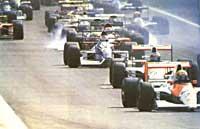
For Formula One riders the 1990 season began on March 11 and since then there is a strong bet between Ferrari and MacLaren or Prost and Senna. There are no jokes on the car tracks. Although technically they have carried the engines and the body to the final limit, the organism of the pilots of the formula one is demanded more than in any other place. The pilot, during the race, hangs the life of a thread having to go fast.
For many years technicians have been very concerned about the performance and reliability of the fireball, but at the same time they have paid little attention to the pilot. When choosing the pilots, they took into account the economic reasons of personal skill and sponsors, without worrying too much about helping their physical and psychological situation.
However, two years ago, French physiologists and biomechanics François Duforez and Pierre Portero started a series of trials. In 1988 they took the pilots Alliot and Dalmas to carry out their experiments, last year Alliot and Alboreto and this year Suzuki and Bernard. Apparently, Alesi is willing to collaborate and Prost has also given the go-ahead.
The first objective of the researchers is to know better the physiology of these arrows of track. The research will have beneficial effects for the pilots from the point of view of safety and performance, but the final goal is to know in what circumstances the normal people (you and I for example) suffer an important psychological stress and a great loss of energy.
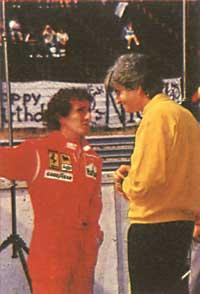
The researchers want to analyze the problem in the 1990 Formula One season in three main aspects: thermoregulation, muscle response to bapat accelerations and hormonal response to stress.
If we consider the last aspect mentioned, in the stress pilots is always related to situations limit of risk. It is not precisely the usual situation of normal people, but if we analyze these people who have not left the living danger, we can see amplified the biochemical changes that can occur in normal life. It is intended to perform a stress analysis and, in short, to clarify the mechanism of diabetes or atherogenesis (know how the atheromal plaque forms that can clog the blood vessels and generate a myocardial infarction).
The formula One for another, is very hard in terms of temperature. Placing the helmet, put in a dress that does not catch fire, the pilot is inserted in a small hole with motor in the back. In addition, the body is designed for the wind to pass over the pilot's head. Therefore, it is not surprising that on the track of Rio de Janeiro or Phoenix the pilot of solar boilers suffers a temperature of 60ºC and loses two liters of sweat per hour.
Pierre Portero says the riders have a fever while driving on the track. The body temperature can rise to 40ºC, so the researchers place chapels on the surface to perform a thermal balance, connecting them directly to the computer system. In addition, they try to relate the data obtained with quantitative and qualitative sweat research. In this way, it is intended to detect the shortage of sodium, potassium, magnesium, calcium, copper, zinc, chromium, etc., which occur in the Formula race or in the physical activity in warm atmosphere, to then recommend an adequate diet.
The Larrousse pilots have a special diet before the race. They feed on slow absorption sugars or glycogens and during the race ingest a liquid stored in a thermo at 12-15 °C. Fast-absorbing glycoids (glucose), slow-metabolized (fructose), vitamin B (to metabolize the glucids) and minerals (to maintain saline balance and avoid cramps) in this drink.
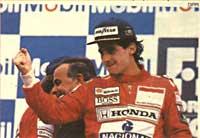
These energy components are good for fighting against the risk of heat stroke, which causes the paralysis of sweat, the thermoregulation of the body and hyperthermia (and sometimes death). In addition, the brain cells spend a lot of glucose and if the blood sugar level decreases, the ingenuity decreases and a feeling of fatigue occurs. This drink, tested with track pilots, will be on sale soon in all pharmacies. Buyers will be athletes, older people and pregnant women.
Researchers Duforez and Goalkeeper, the most studied driver this year is the Japanese Aguri Suzuki. Since the beginning of the year you are experimenting with training. By placing a mask similar to the hunting pilots, during the driving of the fireball telemetry carries out its work recording different parameters. Oxygen consumption heart rate, breathing rate, etc. is shown graphically on a screen. The debate and interpretation of the results is yet to be concluded until the last finite, but all the signs indicate that energy consumption is very high.
He has also been tested by anti-G or anti-gravity pants used by hunting pilots. These pants can be inflated at different pressures and thus blood vessels are more or less compressed. The problem occurs when the forests of the legs are extended and the blood accumulates, so it is opposed to the pressure of the pants. The provisional conclusion would, therefore, be to place elastic supports against the lukewarm.
In the field of stress, the objective is to quantify the hormonal response of the pilot. The eyes have been directed to catecholamines (adrenaline, noradrenaline and cortisol), but also to other metabolic substances such as insulin or growth hormone.
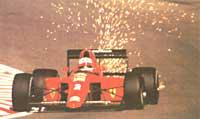
When the level of stress is high, cortisol is secreted and the cortisol causes the discharge of glucose. In the blood a tip of glycemia appears then and immediately a tip of insulin to lower the sugar rate at normal level.
In recent years it is known that free fatty acids reflect psychological stress, a fact that researchers also want to measure.
According to Dr. Duforez, the ideal would be to measure the discharge of adrenaline and to evaluate its influence on the rhythm of the heart (in the most serious moments of the race the heart can reach a rhythm of 180 pulses per minute). But how to take a blood sample to a pilot going at a speed of 300 km/h, or how to take blood stress?
Despite the obstacles, researchers Goalkeeper and Duforez are conducting interesting studies to the pilot Aguri Suzuki. The problem is to measure the effect of stresses on risks on biological parameters. To do this, we must compare the hormonal results in situations that, according to Pierre Portero, are equal in duration, time and energy, but different in terms of stress level. The highest level of stress is given in Formula's own career. As for endurance training, the rider has to walk fast, but since he has no rival nearby, the level of stress is lower. The third level would be to pedal in the laboratory on ergometric bicycle.
The last two levels of stress have already been measured to the pilot Aguri Suzuki and experts say that dehydration and concentration of blood mass in endurance training are much higher by bike than in the same effort.
In the races held in 1989 in France and Canada, the researchers studied the muscular tensions of the pilots. These tensions are due to the longitudinal, transversal and approximate accelerations that the pilot supports in his small seat. The pilot's fireball Philippe Alliot installed a magnetic watchmaker that marked the thousandth second connected to the accelerometer and electrocardiogram apparatus for the three axes.
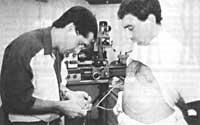
With the helmet, the pilot's head weighs approximately 6.5 kg. In closed curves, accelerations and decelerations can take values between 3 and 5 G. In fact, the fireball barely slips into the curve and the pilot is perfectly stuck in his little box. Therefore, the inner masses of the head move in each curve, in each braking and acceleration. Therefore, the head weighs much more during those seconds and the neck, to which it has to endure, suffers a lot. The neck muscles work hard during the race to maintain the transversal and recession stresses in the head.
In addition, the race tracks are not quite launas and due to the irregularities of the terrain, vertical accelerations can reach values of between 15 and 20 G. The solution is to strengthen the neck muscles or lighten the helmet. They have already begun to lighten the three hundred grams in the kilos and a half of composite head.
Doctors Dufor and Goalkeeper are using electromyography this season. In this way, it is intended to measure the current changes that occur in the neck muscles in the incidences of the track.
The fireworks, pilots and researchers are at full speed. The race is incandescent, but the end looks far away, since when a problem is solved they start to another and there is always another.
Buletina
Bidali zure helbide elektronikoa eta jaso asteroko buletina zure sarrera-ontzian











